Leveraging Education in Emergencies for Climate Action. No Time to Lose: Commit to Resilience and Leaning Now
By Fumiyo Kagawa and David Selby, Geneva Global Hub for Education in Emergencies, Geneva, 2023, 82pp.
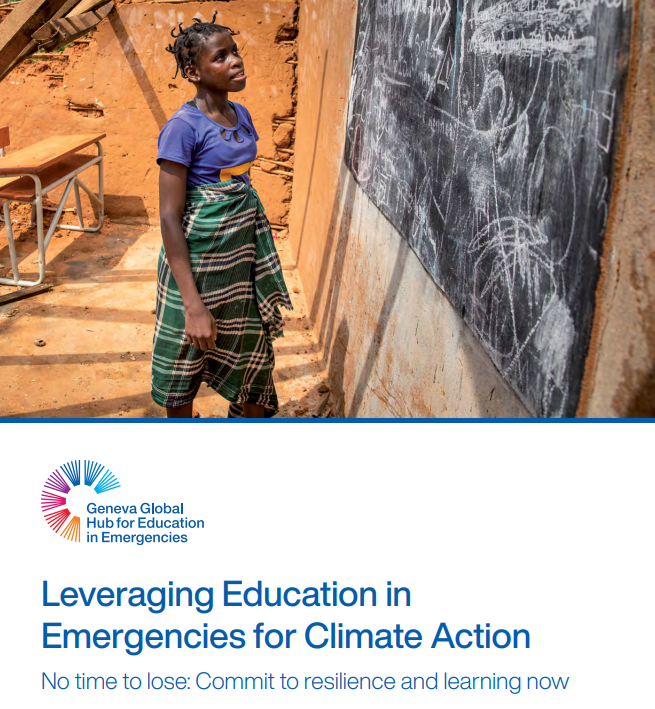 This 2023 Flagship Report commissioned by the Geneva Global Hub for Education in Emergencies (EiE Hub), examines the nexus between climate and environmental breakdown and education in emergencies (EiE). The report begins by providing an overview of unprecedented climate and environmental breakdown that is compounding and exacerbating other risk drivers. It analyses the impacts of climate and environmentally-induced rapid- and slow-onset hazards and shocks on EiE. It then explores key actions taken so far in the EiE response to climate and environmental crises, the challenges faced, and the opportunities emerging. The report includes key recommendations to EiE actors and their partners at global, national and sub-national levels.
This 2023 Flagship Report commissioned by the Geneva Global Hub for Education in Emergencies (EiE Hub), examines the nexus between climate and environmental breakdown and education in emergencies (EiE). The report begins by providing an overview of unprecedented climate and environmental breakdown that is compounding and exacerbating other risk drivers. It analyses the impacts of climate and environmentally-induced rapid- and slow-onset hazards and shocks on EiE. It then explores key actions taken so far in the EiE response to climate and environmental crises, the challenges faced, and the opportunities emerging. The report includes key recommendations to EiE actors and their partners at global, national and sub-national levels.
To access the report, click here.
Quality Education with the Planet in Mind: Towards a Climate-Responsive and Nature-Positive Framework for the Education System of Lower Income Countries
By Fumiyo Kagawa with David Selby, The Global Partnership for Education, Washington DC, Paris, Brussels, 2022 94 pp
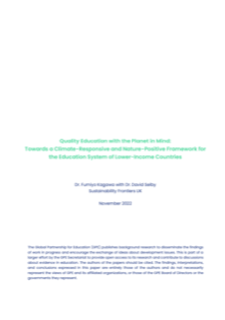 This report, commissioned by the Global Partnership for Education (GPE),
This report, commissioned by the Global Partnership for Education (GPE),
brings together diverse communities of practice working at the nexus of climate change, environmental conservation and protection and education with a view to delineating a more systemic and joined-up approach. It proposes climate-responsive and nature-positive education system that seeks to maximize co-benefits between various efforts to build climate resilience, to restore environmental integrity and to achieve quality, equitable and inclusive education for all.
The framework consists of the three complementary spheres – climate action and justice, risk reduction and management and nature-based solutions – and is thoroughly infused and informed by the three crosscutting themes of child rights and agency, gender equality and social inclusion and cultural diversity.
Building on UNICEF-commissioned research on the impact of and response to climate change across education systems in South Asia (see the Heat is On! Series) a climate-responsive and nature-positive education system framework is perceived as encompassing seven education system dimensions -– policy and planning; finance; physical infrastructure; curriculum, learning and teaching; school community linkages; coordination and partnerships; data and evidence – all in intersecting relationship. Under each dimension, the paper highlights existing approaches, noteworthy examples, current gaps and action points.
To access the paper, click here.
This GPE-commissioned paper significantly informs the GPE working paper, Toward Climate-Smart Education Systems: A 7-Dimension Framework for Action. To access the working paper, click here.
The Heat is On!: Towards Climate Resilient Education Systems in South Asia
By Fumiyo Kagawa, UNICEF Regional Office for South Asia, Kathmandu. 2022, 45pp.
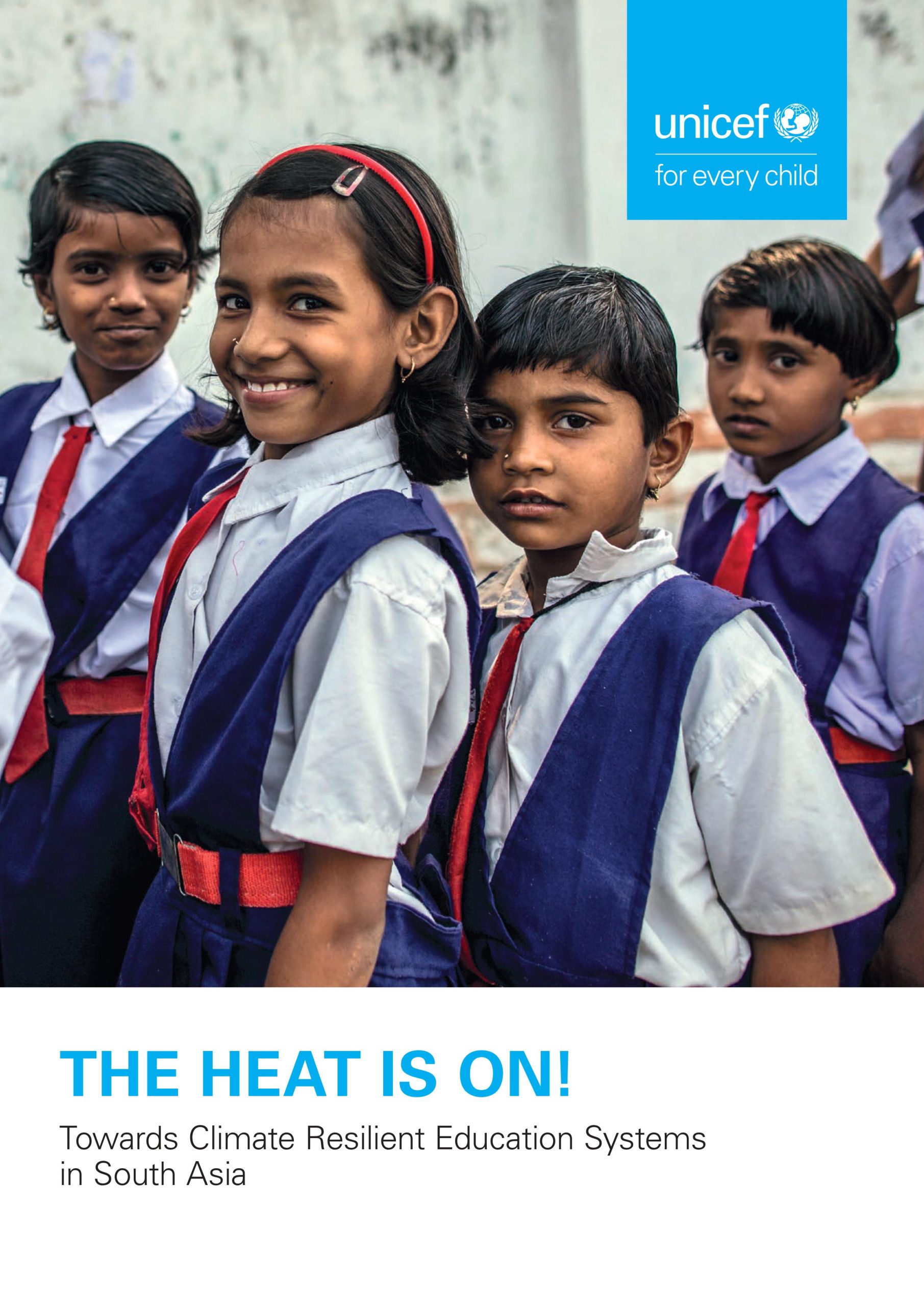 This regional report, commissioned by UNICEF Regional Office for South Asia, synthesizes findings of eight South Asian country studies on the impact of and response to climate change across education systems, highlighting common trends, gaps and examples of noteworthy. Direct and indirect impacts of climate change in the education systems are analysed in terms of learning facilities, educational access, student’s health and wellbeing, and education provision and learning quality. The report includes key recommendations to make education systems in the region more resilient in the face of increasing multifaceted climate change risks. It also includes system-wide standards and progress indicators for climate resilient education systems.
This regional report, commissioned by UNICEF Regional Office for South Asia, synthesizes findings of eight South Asian country studies on the impact of and response to climate change across education systems, highlighting common trends, gaps and examples of noteworthy. Direct and indirect impacts of climate change in the education systems are analysed in terms of learning facilities, educational access, student’s health and wellbeing, and education provision and learning quality. The report includes key recommendations to make education systems in the region more resilient in the face of increasing multifaceted climate change risks. It also includes system-wide standards and progress indicators for climate resilient education systems.
To access the document, click here.
Towards Climate Resilient Education Systems: A Tool for Reflection, Dialogue and Progress Assessment for Ministries of Education and its Partners
By Fumiyo Kagawa, UNICEF Regional Office for South Asia, Kathmandu, 2022, 10pp.
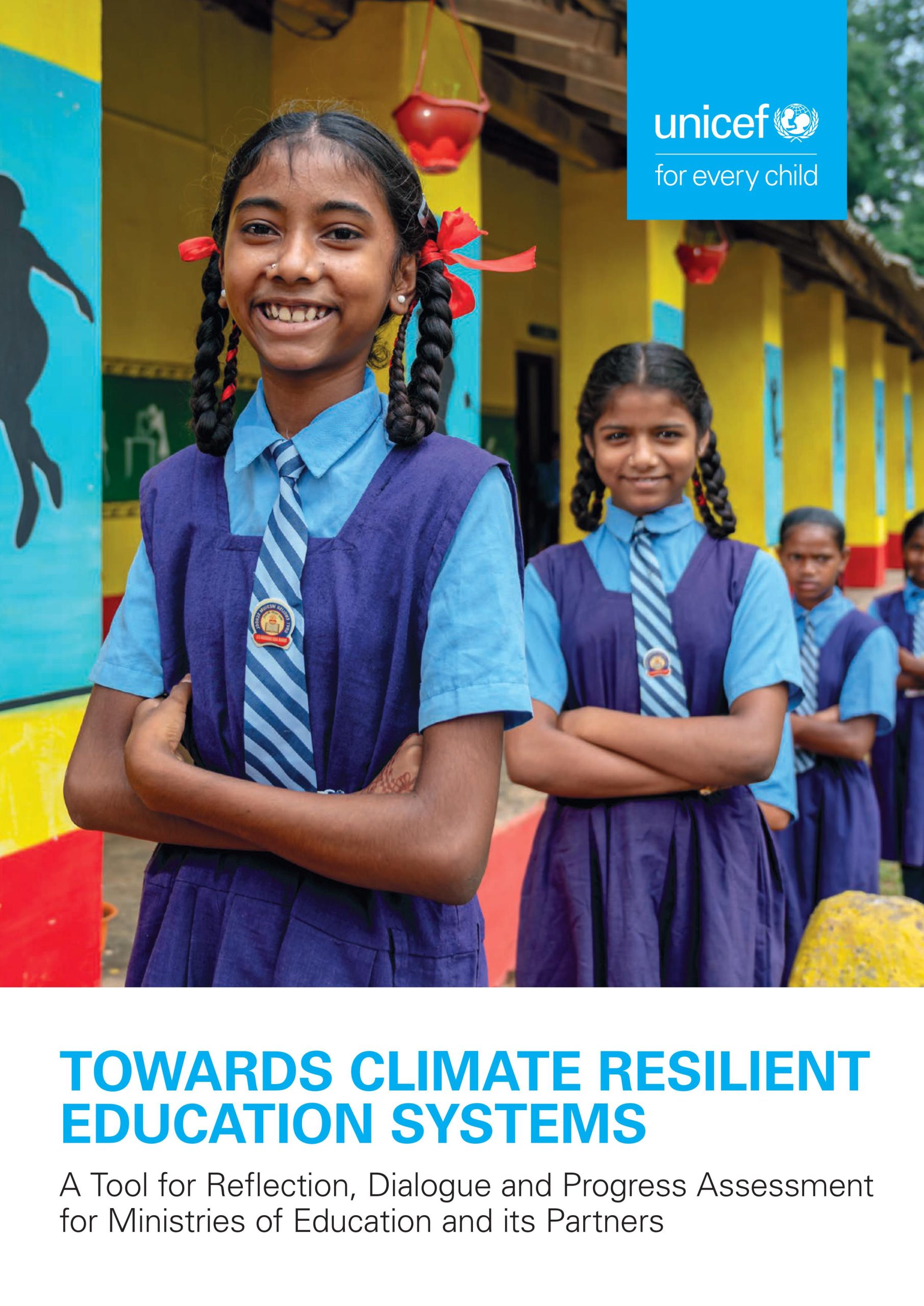 Predicated on the UNICEF Regional Office for South Asia regional study on the impact of and response to climate change across education systems, this tool is designed to raise awareness and promote reflection, dialogue and assessment of progress amongst national and sub-national level education authorities and their partners concerning structures and processes to make the education system more climate resilient. This tool is for ministry of education personnel and their partners to help them assess and discuss whether the education system is moving in the direction of increased climate change responsiveness and thus making progress towards climate change mitigation and adaptation goals. It includes system-wide standards and progress indicators for climate resilient education systems covering key education system components (i.e. Policy, Plans and Strategies; Finance; Curriculum, Teaching and Learning; Teacher Capacity Development; Communication, Coordination and Partnership; School/Community Student Participation Platforms; Monitoring, Evaluation and Accountability).
Predicated on the UNICEF Regional Office for South Asia regional study on the impact of and response to climate change across education systems, this tool is designed to raise awareness and promote reflection, dialogue and assessment of progress amongst national and sub-national level education authorities and their partners concerning structures and processes to make the education system more climate resilient. This tool is for ministry of education personnel and their partners to help them assess and discuss whether the education system is moving in the direction of increased climate change responsiveness and thus making progress towards climate change mitigation and adaptation goals. It includes system-wide standards and progress indicators for climate resilient education systems covering key education system components (i.e. Policy, Plans and Strategies; Finance; Curriculum, Teaching and Learning; Teacher Capacity Development; Communication, Coordination and Partnership; School/Community Student Participation Platforms; Monitoring, Evaluation and Accountability).
To access the document, click here.
The Heat is On!: Towards a Climate Resilient Education System in Bangladesh
By Fumiyo Kagawa, UNICEF Regional Office for South Asia, Kathmandu, 2022, 42pp.
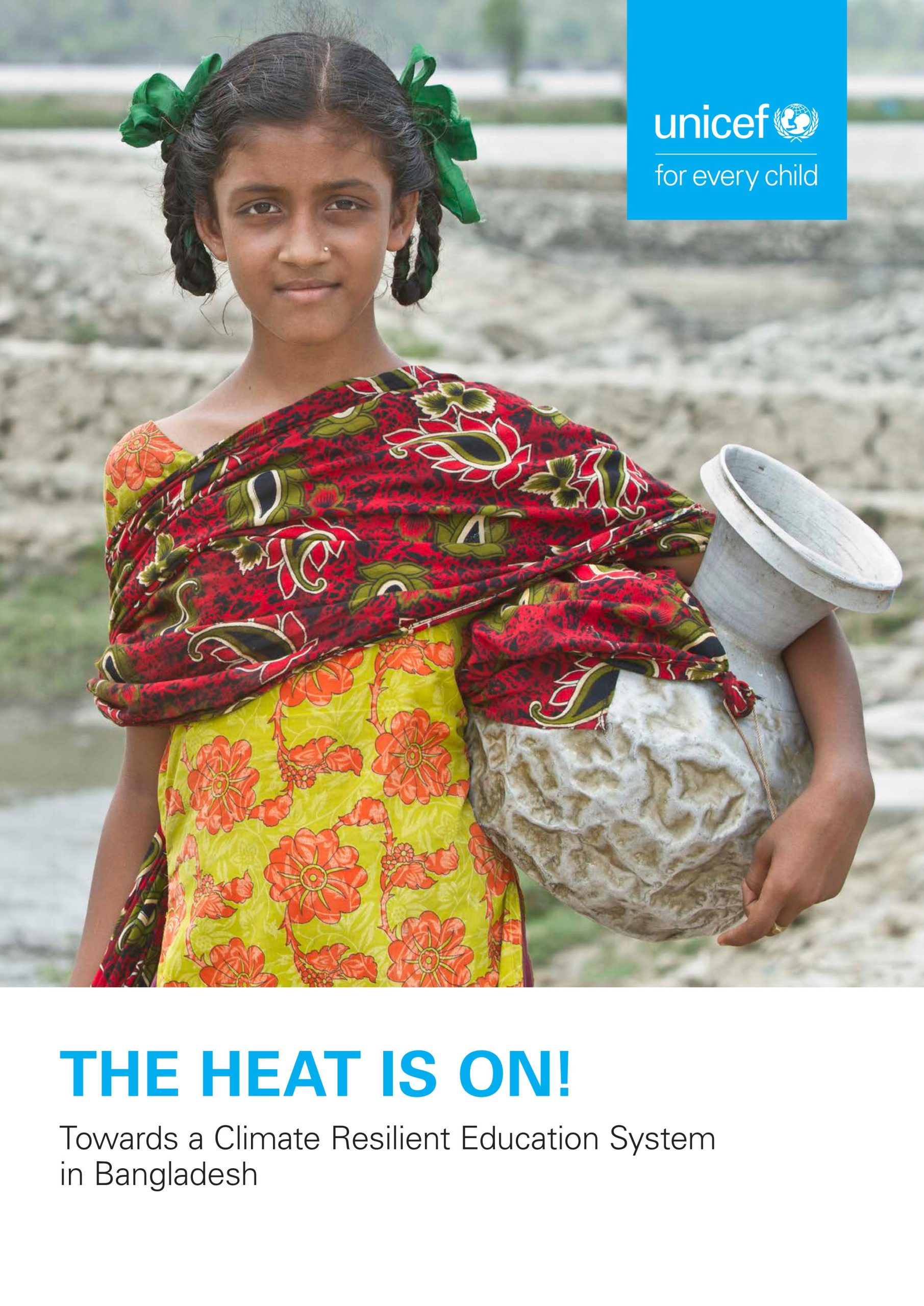
This study, commissioned by UNICEF Regional Office for South Asia, examines the direct and indirect impacts of climate change on the education system in Bangladesh in terms of learning facilities, education access, student health and wellbeing and education provision and learning quality. It also analyses education sector responses to climate change, exploring seven key education system components (i.e. Policy, Plans and Strategies; Finance; Curriculum, Teaching and Learning; Teacher Capacity Development; Communication, Coordination and Partnership; School/Community Student Participation Platforms; Monitoring, Evaluation and Accountability). It offers key recommendations aimed at making the education system in Bangladesh more resilient in the face of increasing multifaceted climate change risk.
To access the document, click here.
The Heat is On!: Towards a Climate Resilient Education System in Bhutan. UNICEF Regional Office for South Asia: Kathmandu.
By Fumiyo Kagawa, UNICEF Regional Office for South Asia, Kathmandu, 2022, 35pp.
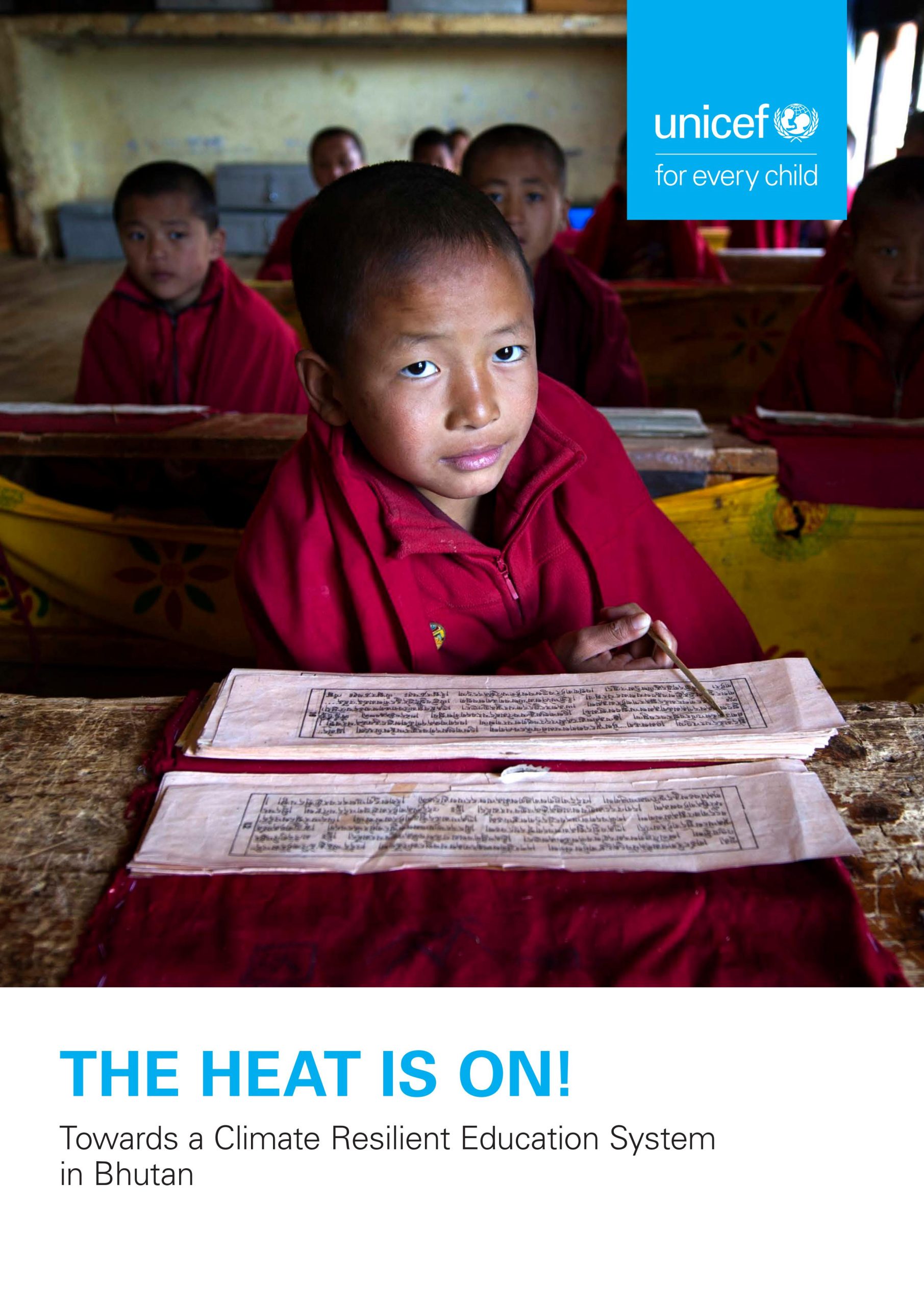 This study, commissioned by UNICEF Regional Office for South Asia, examines the direct and indirect impacts of climate change on the education system in Bhutan in terms of learning facilities, education access, student health and wellbeing and education provision and learning quality. It also analyses education sector responses to climate change, exploring seven key education system components (i.e. Policy, Plans and Strategies; Finance; Curriculum, Teaching and Learning; Teacher Capacity Development; Communication, Coordination and Partnership; School/Community Student Participation Platforms; Monitoring, Evaluation and Accountability). It offers key recommendations aimed at making the education system in Bhutan more resilient in the face of increasing multifaceted climate change risk.
This study, commissioned by UNICEF Regional Office for South Asia, examines the direct and indirect impacts of climate change on the education system in Bhutan in terms of learning facilities, education access, student health and wellbeing and education provision and learning quality. It also analyses education sector responses to climate change, exploring seven key education system components (i.e. Policy, Plans and Strategies; Finance; Curriculum, Teaching and Learning; Teacher Capacity Development; Communication, Coordination and Partnership; School/Community Student Participation Platforms; Monitoring, Evaluation and Accountability). It offers key recommendations aimed at making the education system in Bhutan more resilient in the face of increasing multifaceted climate change risk.
To access the document, click here.
The Heat is On!: Towards a Climate Resilient Education System in India
By Fumiyo Kagawa, UNICEF Regional Office for South Asia, Kathmandu, 2022, 47pp.
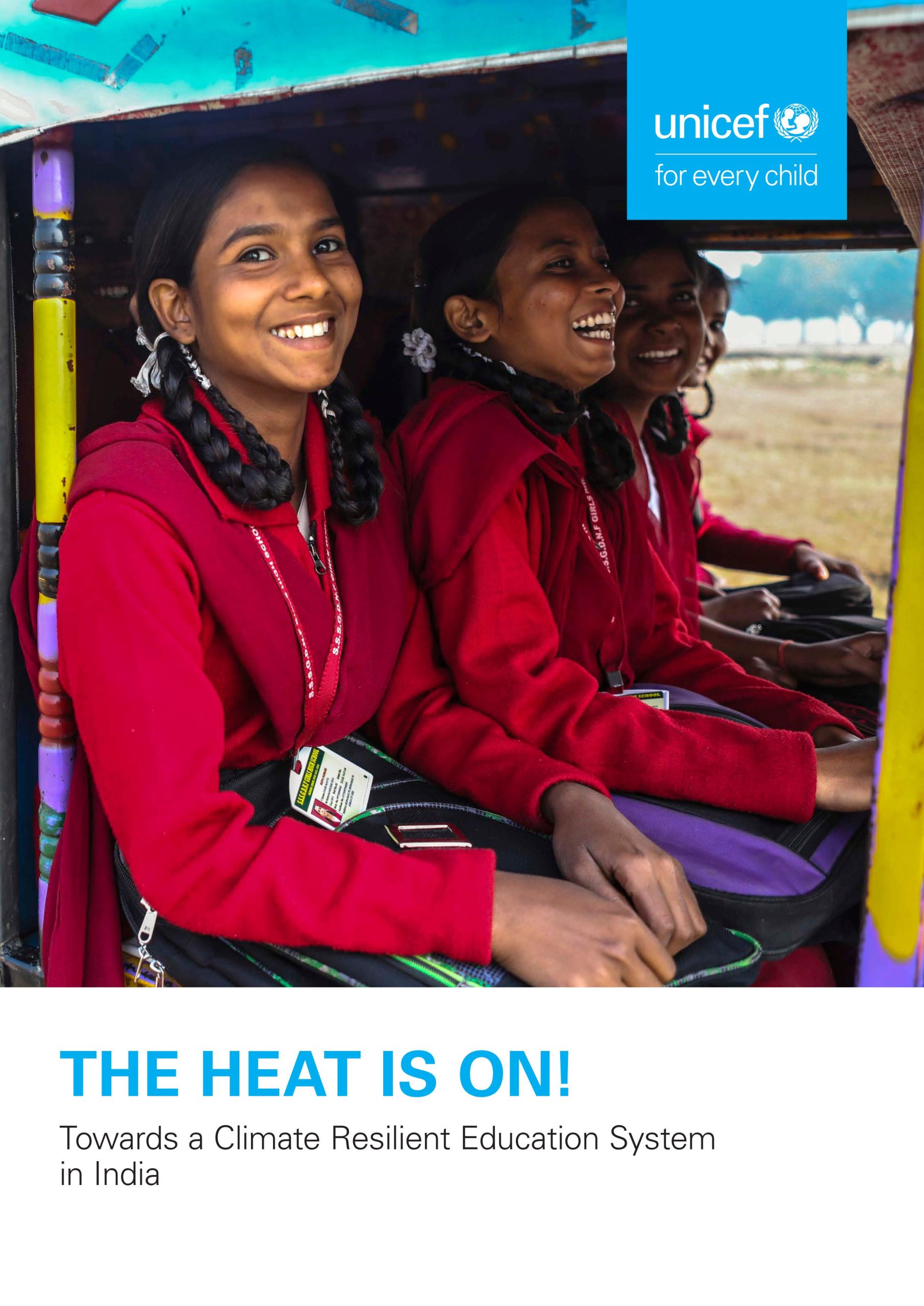 This study, commissioned by UNICEF Regional Office for South Asia, examines the direct and indirect impacts of climate change on the education system in India in terms of learning facilities, education access, student health and wellbeing and education provision and learning quality. It also analyses education sector responses to climate change, exploring seven key education system components (i.e. Policy, Plans and Strategies; Finance; Curriculum, Teaching and Learning; Teacher Capacity Development; Communication, Coordination and Partnership; School/Community Student Participation Platforms; Monitoring, Evaluation and Accountability). The study is primarily focused at the national level with attention given to three Indian states: Bihar, Kerala and Odisha. It offers key recommendations aimed at making the education system in India more resilient in the face of increasing multifaceted climate change risk.
This study, commissioned by UNICEF Regional Office for South Asia, examines the direct and indirect impacts of climate change on the education system in India in terms of learning facilities, education access, student health and wellbeing and education provision and learning quality. It also analyses education sector responses to climate change, exploring seven key education system components (i.e. Policy, Plans and Strategies; Finance; Curriculum, Teaching and Learning; Teacher Capacity Development; Communication, Coordination and Partnership; School/Community Student Participation Platforms; Monitoring, Evaluation and Accountability). The study is primarily focused at the national level with attention given to three Indian states: Bihar, Kerala and Odisha. It offers key recommendations aimed at making the education system in India more resilient in the face of increasing multifaceted climate change risk.
To access the document, click here.
The Heat is On!: Towards a Climate Resilient Education System in the Maldives
By Fumiyo Kagawa, UNICEF Regional Office for South Asia, Kathmandu, 2022, 38pp.
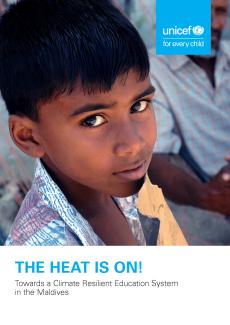 This study, commissioned by UNICEF Regional Office for South Asia, examines the direct and indirect impacts of climate change on the education system in the Maldives in terms of learning facilities, education access, student health and wellbeing and education provision and learning quality. It also analyses education sector responses to climate change, exploring seven key education system components (i.e. Policy, Plans and Strategies; Finance; Curriculum, Teaching and Learning; Teacher Capacity Development; Communication, Coordination and Partnership; School/Community Student Participation Platforms; Monitoring, Evaluation and Accountability). It offers key recommendations aimed at making the education system in the Maldives more resilient in the face of increasing multifaceted climate change risk.
This study, commissioned by UNICEF Regional Office for South Asia, examines the direct and indirect impacts of climate change on the education system in the Maldives in terms of learning facilities, education access, student health and wellbeing and education provision and learning quality. It also analyses education sector responses to climate change, exploring seven key education system components (i.e. Policy, Plans and Strategies; Finance; Curriculum, Teaching and Learning; Teacher Capacity Development; Communication, Coordination and Partnership; School/Community Student Participation Platforms; Monitoring, Evaluation and Accountability). It offers key recommendations aimed at making the education system in the Maldives more resilient in the face of increasing multifaceted climate change risk.
To access the document, click here.
The Heat is On! Towards a Climate Resilient Education System in Nepal
By Fumiyo Kagawa, UNICEF Regional Office for South Asia, Kathmandu, 2022, 37pp.
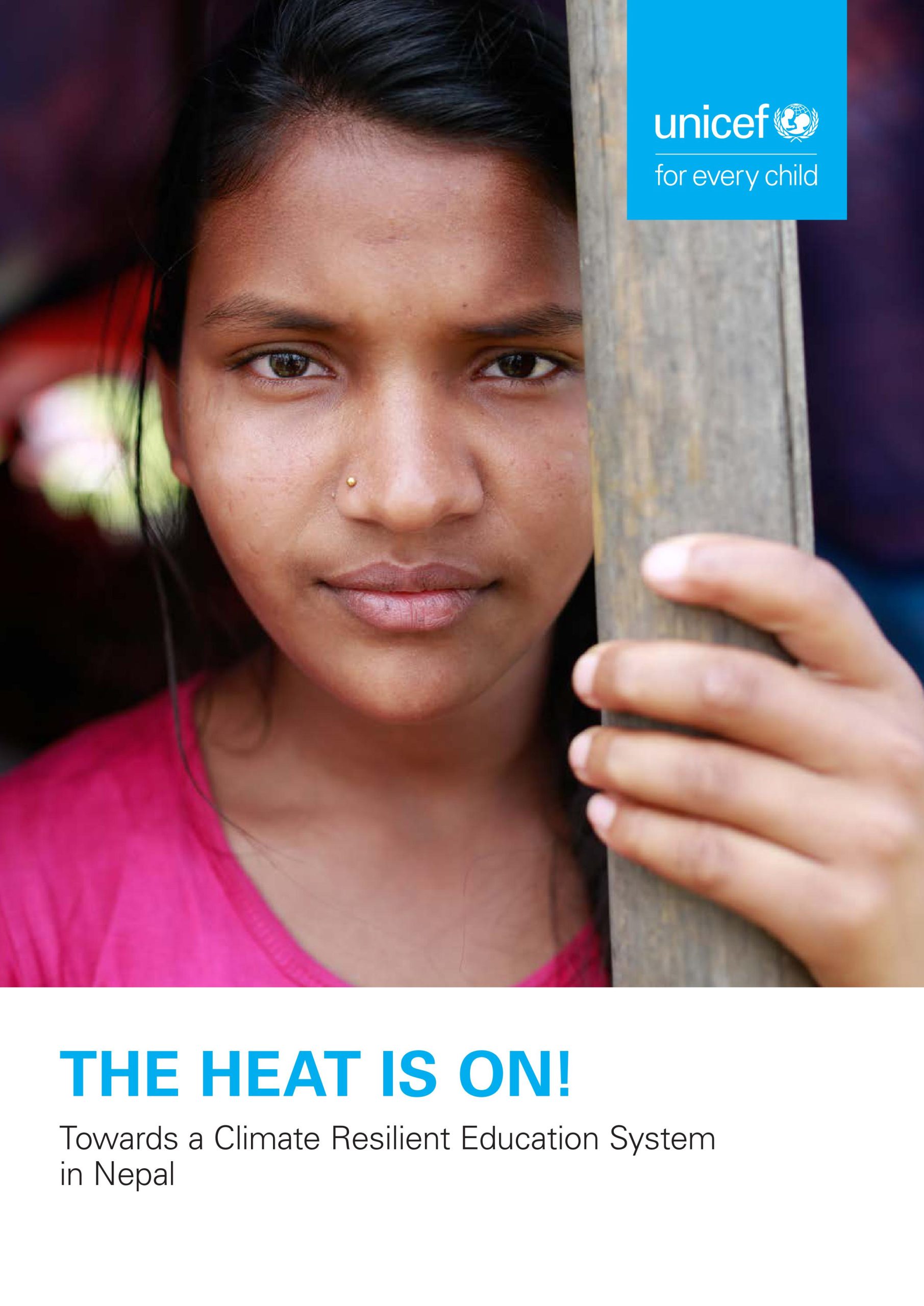
This study, commissioned by UNICEF Regional Office for South Asia, examines the direct and indirect impacts of climate change on the education system in Nepal in terms of learning facilities, education access, student health and wellbeing and education provision and learning quality. It also analyses education sector responses to climate change, exploring seven key education system components (i.e. Policy, Plans and Strategies; Finance; Curriculum, Teaching and Learning; Teacher Capacity Development; Communication, Coordination and Partnership; School/Community Student Participation Platforms; Monitoring, Evaluation and Accountability). It offers key recommendations aimed at making the education system in Nepal more resilient in the face of increasing multifaceted climate change risk.
To access the document, click here.
The Heat is On!: Towards a Climate Resilient Education System in Pakistan
By Fumiyo Kagawa, UNICEF Regional Office for South Asia, Kathmandu, 2022, 38pp.
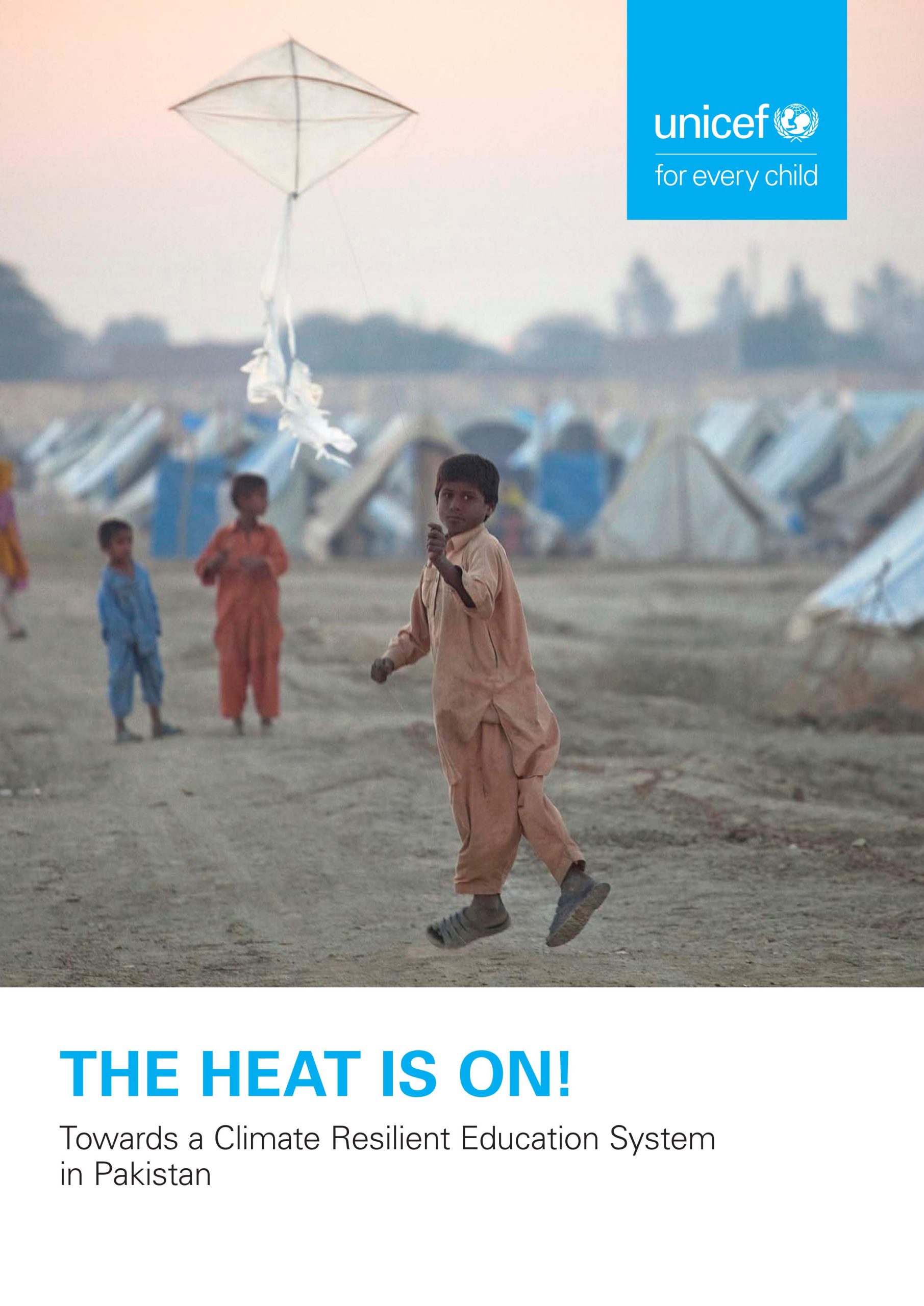 This study, commissioned by UNICEF Regional Office for South Asia, examines the direct and indirect impacts of climate change on the education system in Pakistan in terms of learning facilities, education access, student health and wellbeing and education provision and learning quality. It also analyses education sector responses to climate change, exploring seven key education system components (i.e. Policy, Plans and Strategies; Finance; Curriculum, Teaching and Learning; Teacher Capacity Development; Communication, Coordination and Partnership; School/Community Student Participation Platforms; Monitoring, Evaluation and Accountability). It offers key recommendations aimed at making the education system in Pakistan more resilient in the face of increasing multifaceted climate change risk.
This study, commissioned by UNICEF Regional Office for South Asia, examines the direct and indirect impacts of climate change on the education system in Pakistan in terms of learning facilities, education access, student health and wellbeing and education provision and learning quality. It also analyses education sector responses to climate change, exploring seven key education system components (i.e. Policy, Plans and Strategies; Finance; Curriculum, Teaching and Learning; Teacher Capacity Development; Communication, Coordination and Partnership; School/Community Student Participation Platforms; Monitoring, Evaluation and Accountability). It offers key recommendations aimed at making the education system in Pakistan more resilient in the face of increasing multifaceted climate change risk.
To access the document, click here.
The Heat is On!: Towards a Climate Resilient Education System Sri Lanka
By Fumiyo Kagawa, UNICEF Regional Office for South Asia, Kathmandu, 2022, 33pp.
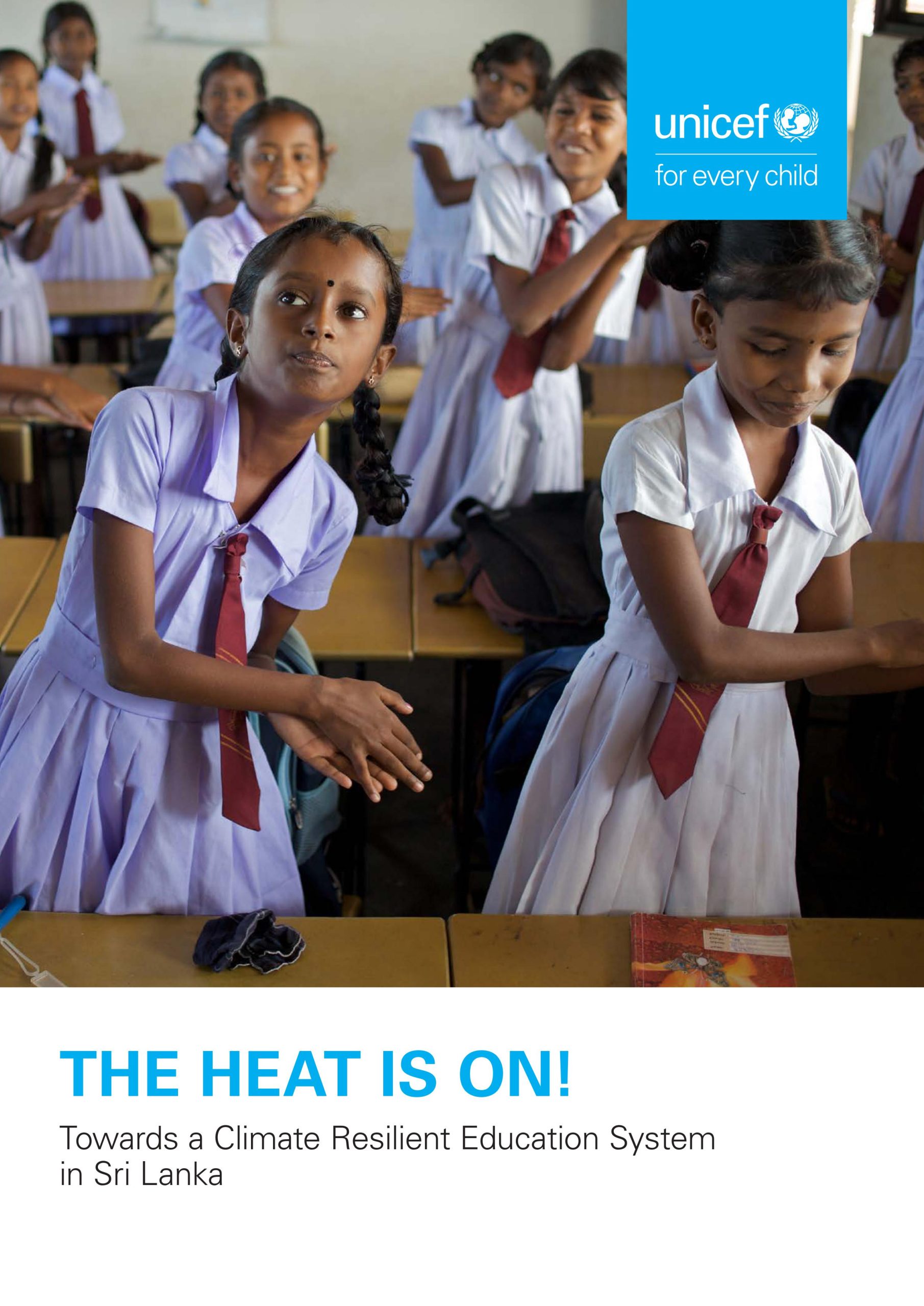 This study, commissioned by UNICEF Regional Office for South Asia, examines the direct and indirect impacts of climate change on the education system in Sri Lanka in terms of learning facilities, education access, student health and wellbeing and education provision and learning quality. It also analyses education sector responses to climate change, exploring seven key education system components (i.e. Policy, Plans and Strategies; Finance; Curriculum, Teaching and Learning; Teacher Capacity Development; Communication, Coordination and Partnership; School/Community Student Participation Platforms; Monitoring, Evaluation and Accountability). It offers key recommendations aimed at making the education system in Sri Lanka more resilient in the face of increasing multifaceted climate change risk.
This study, commissioned by UNICEF Regional Office for South Asia, examines the direct and indirect impacts of climate change on the education system in Sri Lanka in terms of learning facilities, education access, student health and wellbeing and education provision and learning quality. It also analyses education sector responses to climate change, exploring seven key education system components (i.e. Policy, Plans and Strategies; Finance; Curriculum, Teaching and Learning; Teacher Capacity Development; Communication, Coordination and Partnership; School/Community Student Participation Platforms; Monitoring, Evaluation and Accountability). It offers key recommendations aimed at making the education system in Sri Lanka more resilient in the face of increasing multifaceted climate change risk.
To access the document, click here.
Working Together for Resilience: Linkages between School-Based Disaster Risk Management and Community-Based Disaster Risk Management
By David Selby & Fumiyo Kagawa, HOPE’ 87 & Sustainability Frontiers, Islamabad/Sidmouth, 121pp.
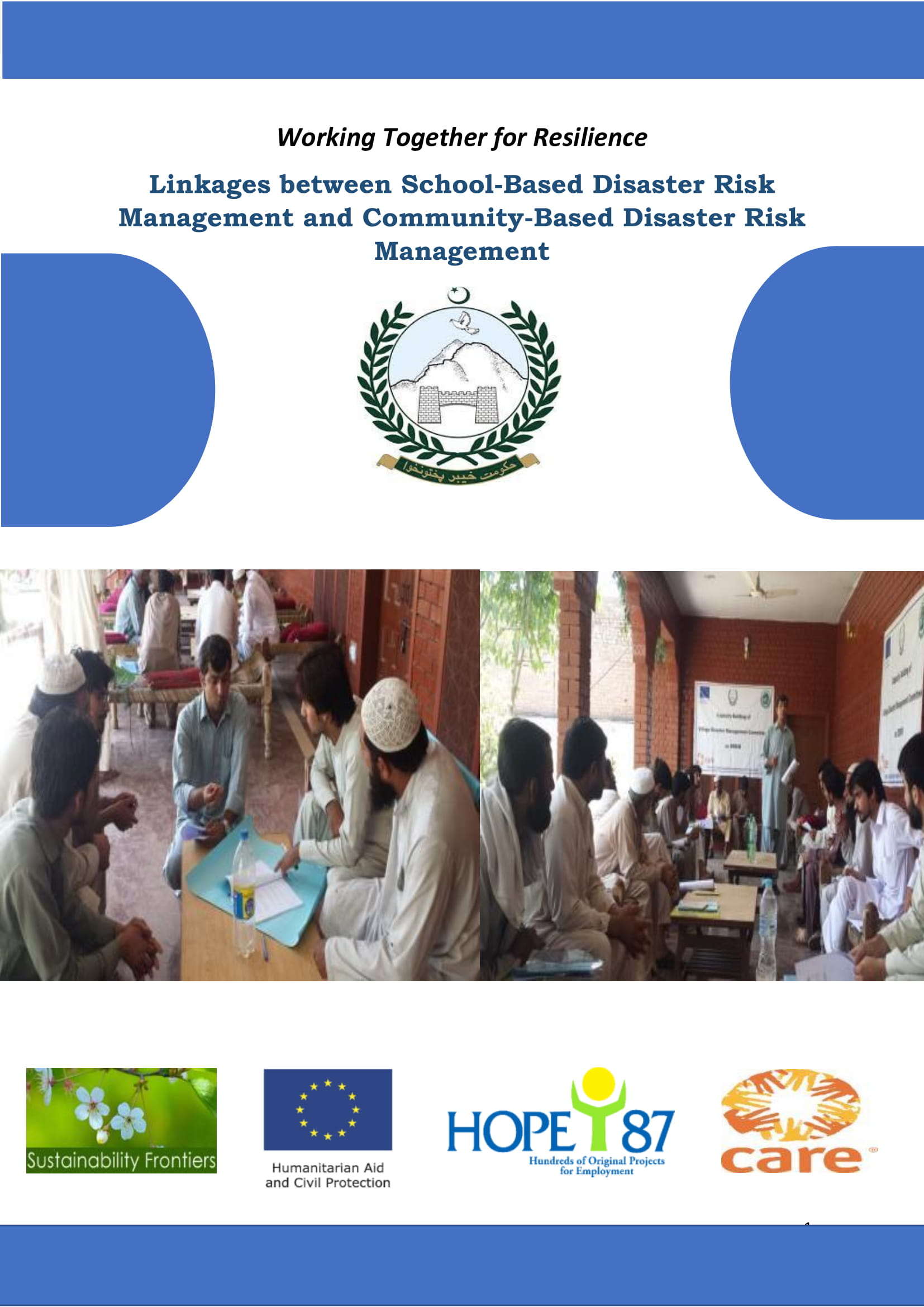
This study is a product of the close collaborative partnership between HOPE’87, Pakistan, and Sustainability Frontiers, UK on disaster risk management in the education sector.
The study begins by offering a rationale for locating disaster risk management in communities and by laying out key features of community-based disaster risk management (CBDRM). It then explores school-based disaster risk management (SBDRM) as an element of comprehensive school safety and examines its key features. Practical means of interlinking and integrating CBDRM and SBDRM are explored including, amongst others, cross-representation on disaster risk management committees, opening informational flows between school and community disaster risk management bodies, joint planning mechanisms and processes, giving the community an active role on school-based disaster risk management bodies, instituting overlapping disaster risk management capacity building, making the school the hub and laboratory for whole-community disaster risk management, and maximising the contribution youth and children can make to both CBDRM and SBDRM.
The document then lays out six models for implementing and achieving interlinked and integrated CBDRM and SBDRM based, in part, upon interview contributions from key stakeholders. Three of the models concern developing an integrated approach within a specific locality; a fourth looks at a multi-locality school-cluster approach to linking CBDRM and SBDRM; the fifth and sixth models shift the focus to one of vertical interlinking of school and locality level, district level and provincial level disaster risk management efforts. The publication ends with a researched account and analysis of the implementation of the three locally-based models in four village locations in Khyber Pakhtunkhwa Province, Pakistan.
To access the document, click here.
Learn, Practice, Share: A Comparative Review of The Pillowcase Project
By David Selby & Fumiyo Kagawa. Global Disaster Preparedness Center (GDPC), Washington D.C. 107pp.
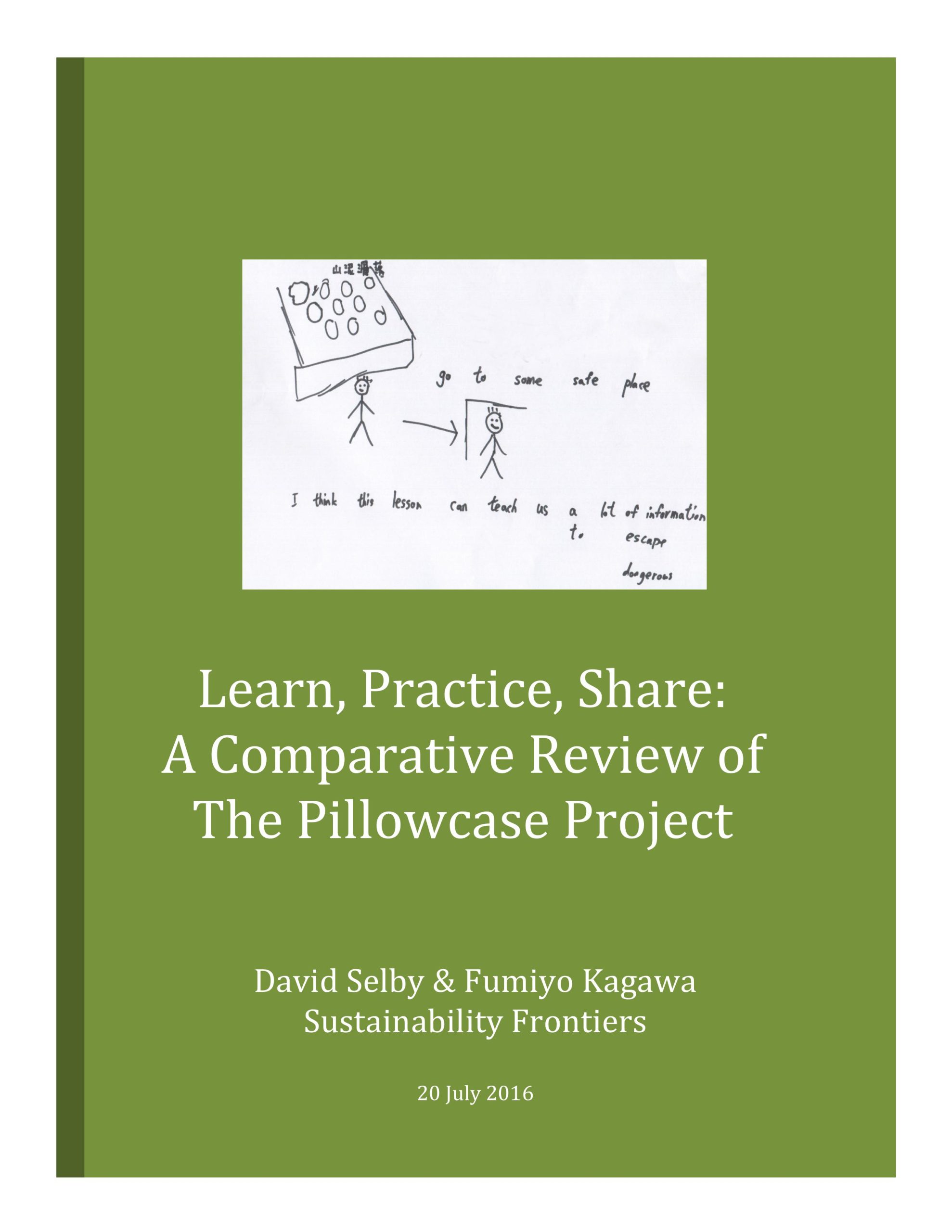
This is an output from a 2016 partnership between Sustainability Frontiers and the Global Disaster Preparedness Center (GDPC), a joint venture of the International Federation of Red Cross and Red Crescent Societies (IFRC) and American Red Cross. This report presents key insights and findings from a comparative review of the Pillowcase Project, a structured (Learn, Practice and Share), active and child-centered disaster preparedness program for children generally aged 8 to 11 (grades 3-5). First developed in the wake of Hurricane Katrina in 2005 by the Southeast Louisiana Red Cross Chapter, it had spread across the USA and subsequently moved on to international piloting by Red Cross national societies in six jurisdictions: Australia, Hong Kong, Mexico, Peru, the United Kingdom and Vietnam.
This review includes case studies from the originating country, the USA, and the six piloting jurisdictions, each highlighting the unique development and implementation strategies and styles adopted as well as factors influencing decisions made and directions taken. A critical, comparative discussion of findings relating to principal facets of the Pillowcase Project together with 18 recommendations follows.
http://preparecenter.org/resources/comparative-review-pillowcase-project
Disaster Risk Reduction in the School Curriculum, the Present and Potential Role of Development Agencies and the implications for the Hyogo Framework for Action 2005-2015 Successor
By Fumiyo Kagawa & David Selby, UNISDR, Geneva, 2015, 47pp.
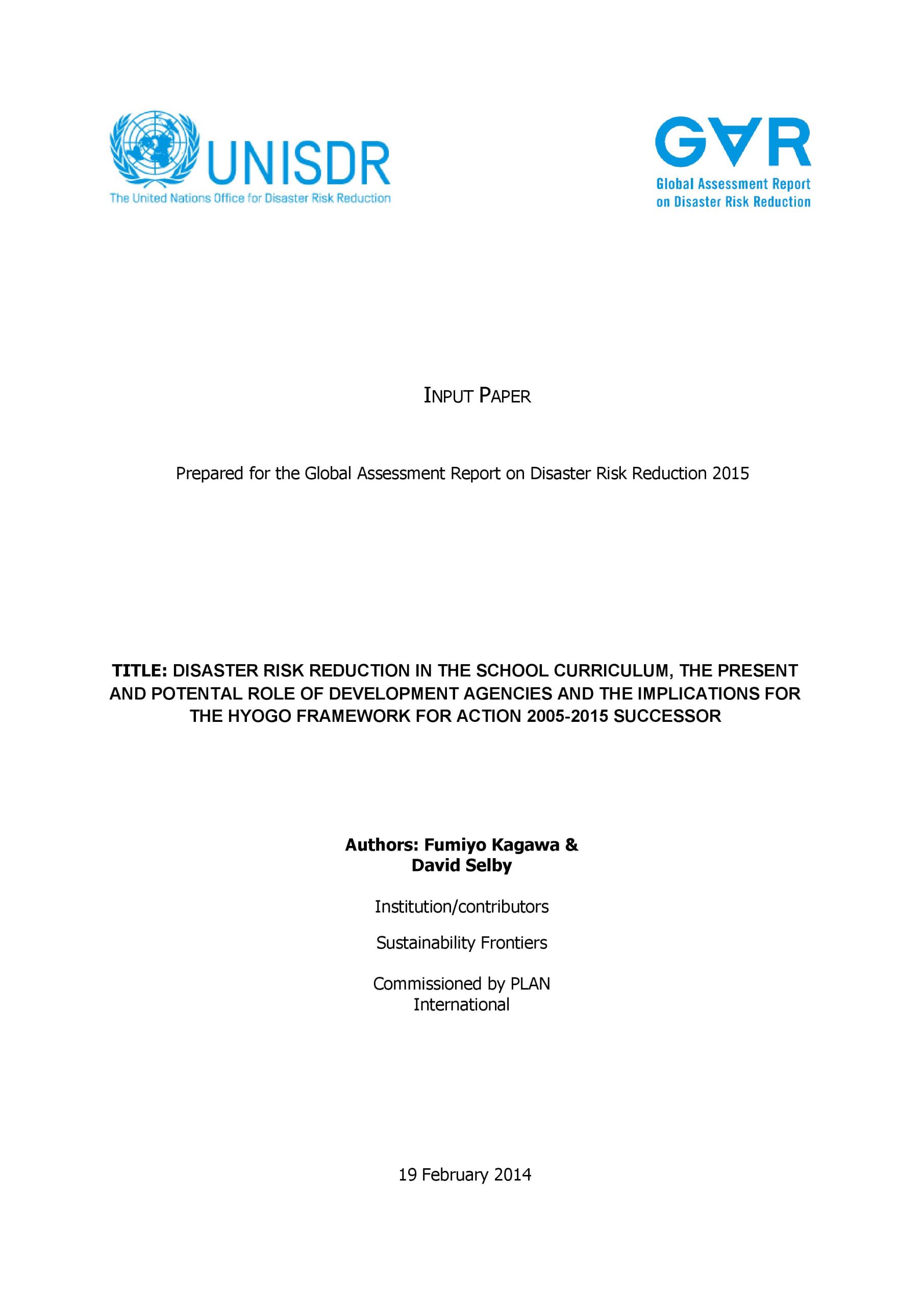
This Input Paper for the Global Assessment Report on Disaster Risk Reduction 2015, commissioned by Plan International Sweden, examines disaster risk reduction (DRR) pre-school, school and post-secondary curricular provision in four South Asian and South East Asian countries (Bangladesh, Cambodia, Indonesia and Pakistan) while also reviewing inter-linkages between DRR teaching and learning and other components of a comprehensive approach to DRR in school and community. It also explores how development agencies are contributing – and might in the future contribute – to DRR curriculum development. It concludes by flagging the implications of the study for the successor document to the Hyogo Framework for Action 2005-2015.
The Global Assessment Report was designed to inform the deliberations of the UN World Conference on Disaster Risk Reduction (WCDRR) held March 14-18, 2015 in Sendai, Japan.
To access the document, click here.
Child-Friendly Schooling for Peacebuilding
By David Selby & Fumiyo Kagawa, UNICEF, New York, 2014, 124pp
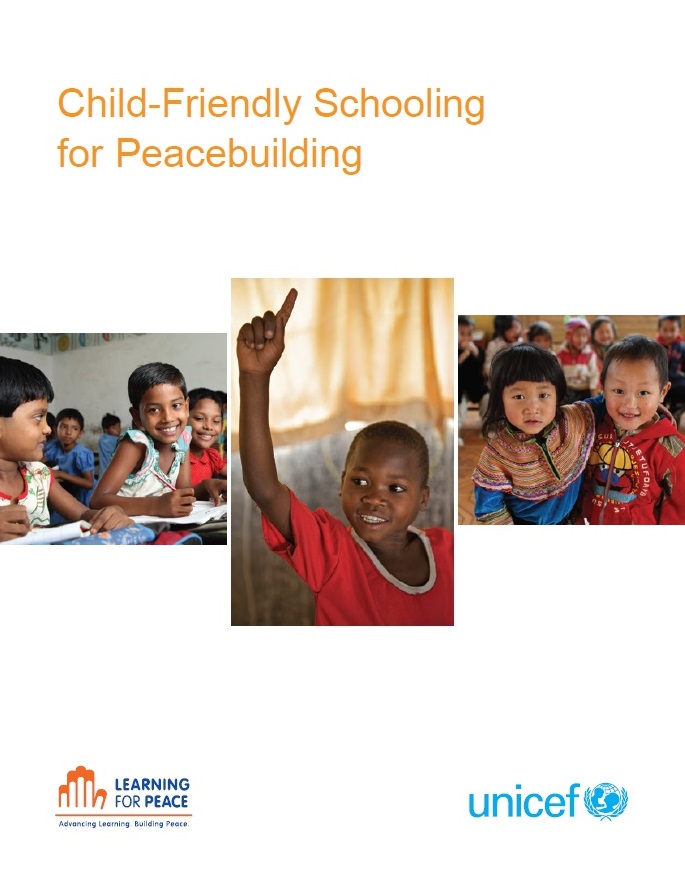
This cutting-edge volume critically examines UNICEF child-friendly school theory and practice from a peacebuilding perspective and offers some twenty-eight illustrative case studies from countries experiencing or emerging from conflict in Africa, Asia, Latin America, Middle East and South-eastern Europe. After examining key principles, key concepts and primary features of both the child-friendly school and peacebuiilding education, and having advanced a socio-ecological model of transformative educational change, the authors explore different elements of the child-friendly school through a peacebuilding lens identifying whether each elements is ‘peacebuilding resonant’ or of ‘peacebuilding latent’ potential or whether it constitutes a ‘peacebuilding gap. School-level elements explored are school physical environment; school culture; curriculum; child-centered learning; student participation at school and in the community; the school as a community hub; the school as a learning organization. System-wide elements explored include: teacher professional development, the use of situation analyses, multi-sector and multi-level partnership approaches, national policy development, national-level child-friendly school teams, and national-level monitoring and evaluation. Risks and vulnerabilities that might follow from the application of child-friendly schooling for peacebuilding are then enumerated. The main text ends with recommendations for making child-friendly schooling more peacebuilding resonant. The publication also includes user friendly standards and indicators for child-friendly schools for peacebuilding in post-conflict context.
In English
Towards a Learning Culture of Safety and Resilience: Technical Guidance for Integrating Disaster Risk Reduction in the School Curriculum
By David Selby & Fumiyo Kagawa, UNESCO/UNICEF, 2014, 229pp.
Towards a Learning Culture of Safety and Resilience: Technical Guidance for Integrating Disaster Risk Reduction in the School Curriculum (Pilot Version)
By David Selby & Fumiyo Kagawa, UNESCO/UNICEF, 2013, 192pp.
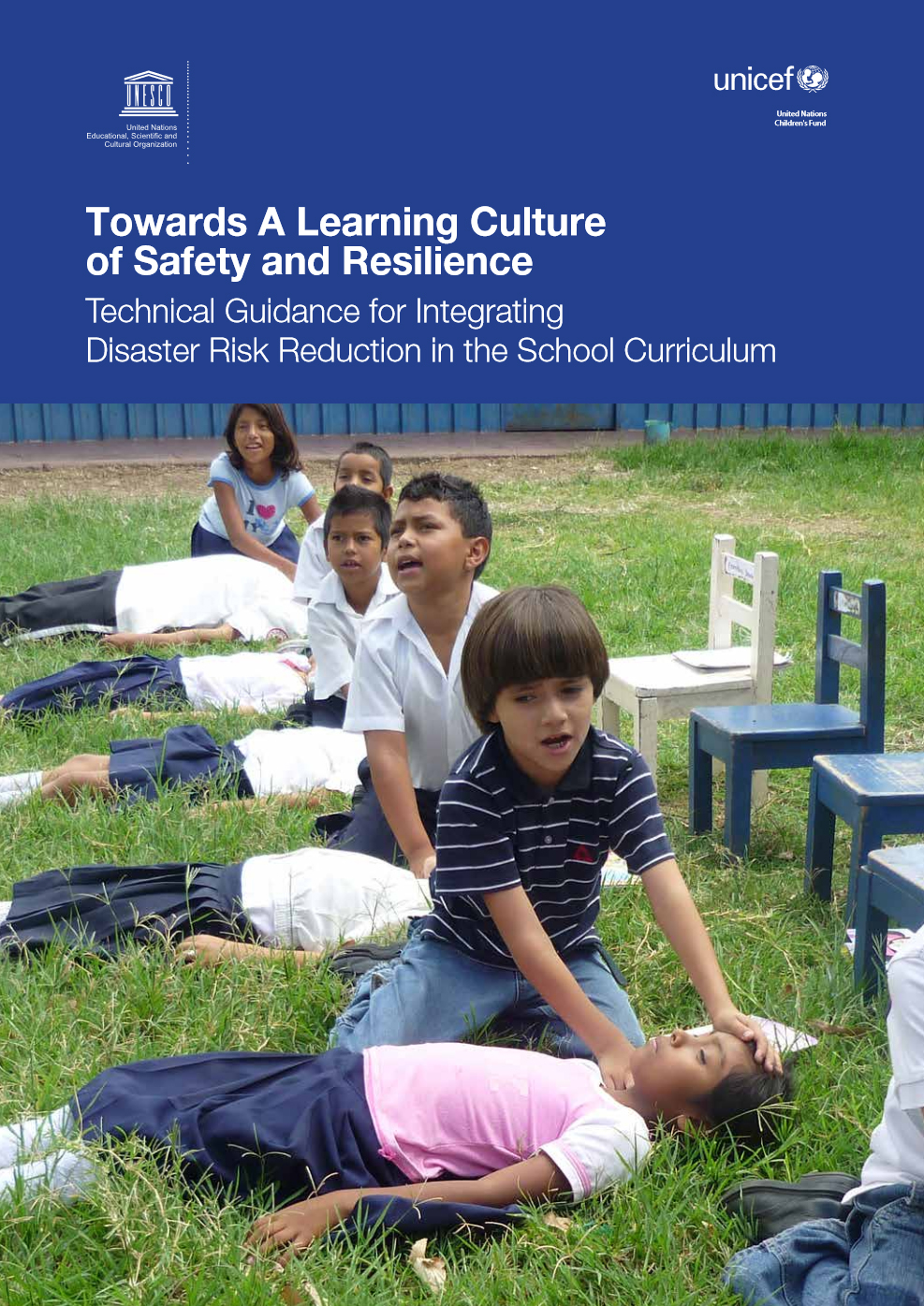 This groundbreaking document, the outcome of a UNESCO/UNICEF consultancy to develop technical guidance for ministries of education, other educational jurisdictions, international and national non-governmental organizations and those in multiplier positions within education, offers in-depth guidance on integrating disaster risk reduction in school curricula. It first offers a rationale for disaster risk reduction education (DRRE) explaining the benefits of introducing disaster risk reduction (DRR) into the curriculum within an Education for Sustainable Development frame and, more broadly, within a quality education framework that also includes climate change education, life skills education and child-friendly education. It goes on to: present a typology and discussion of different approaches and strategies for integrating DRR in the curriculum
; give guidance on the formulation of DRR curriculum goals and grade-related learning objectives
; demonstrate alternative teaching approaches, alternative ways of sequencing knowledge, skills and attitudinal development, and different ways of progressing learning materials development
; provide benchmarks and reference standards for monitoring and evaluating student progress
; showcase relevant planning, assessment, review and discussion tools relating to DRR curriculum development
; provide case study examples of successful integration of DRR into school curricula and practice
; offer guidance on the scaling up and mainstreaming of DRR curriculum initiatives within education systems; demonstrate how to monitor and evaluate DRR curriculum change.
This groundbreaking document, the outcome of a UNESCO/UNICEF consultancy to develop technical guidance for ministries of education, other educational jurisdictions, international and national non-governmental organizations and those in multiplier positions within education, offers in-depth guidance on integrating disaster risk reduction in school curricula. It first offers a rationale for disaster risk reduction education (DRRE) explaining the benefits of introducing disaster risk reduction (DRR) into the curriculum within an Education for Sustainable Development frame and, more broadly, within a quality education framework that also includes climate change education, life skills education and child-friendly education. It goes on to: present a typology and discussion of different approaches and strategies for integrating DRR in the curriculum
; give guidance on the formulation of DRR curriculum goals and grade-related learning objectives
; demonstrate alternative teaching approaches, alternative ways of sequencing knowledge, skills and attitudinal development, and different ways of progressing learning materials development
; provide benchmarks and reference standards for monitoring and evaluating student progress
; showcase relevant planning, assessment, review and discussion tools relating to DRR curriculum development
; provide case study examples of successful integration of DRR into school curricula and practice
; offer guidance on the scaling up and mainstreaming of DRR curriculum initiatives within education systems; demonstrate how to monitor and evaluate DRR curriculum change.
http://unesdoc.unesco.org/images/0022/002293/229336e.pdf (English)
https://unesdoc.unesco.org/ark:/48223/pf0000229336_nep (Nepali)
https://unesdoc.unesco.org/ark:/48223/pf0000234775 (Spanish)
Pilot Version
http://unesdoc.unesco.org/images/0021/002194/219412e.pdf
Enhancing Child-centered Disaster Risk Reduction for Safe Schools: Insights from Cambodia, China and Indonesia
By Fumiyo Kagawa & David Selby, Plan Asia Regional Office, Bangkok, 2013. 137pp.
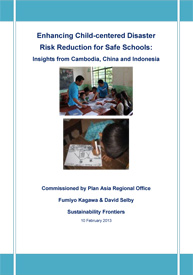 This report presents the findings of safe school research conducted in Cambodia, China and Indonesia, September 2012 to February 2013. The main objective of the research was to examine a child rights approach to school safety within the overall aim of ensuring children’s access to quality education. Drawing on interviews with key stakeholders in Plan International’s participatory, rights-based approach to safe schools, Child Centered Disaster Risk Reduction (CCDRR), the report highlights key developments and achievements in the three countries at national and sub-national levels, identifying what is common and what is distinctive in the experiences of the three countries. The research identifies a gap between the child rights participatory philosophy expounded by Plan and partner organizations and the majority of research participants for whom child participation is more or less a matter of children being active as they follow adult instruction. It also finds that there is much to do in applying a child rights active participation philosophy to the engagement of marginalized children in safe school developments. The report recommends developing synergies between disaster risk reduction initiatives and other initiatives aimed at quality education (e.g. child-friendly education, climate change education, life skills education). It also calls for more thoroughgoing cross-curricular and through-the-grades attention to safety and risk reduction and greater grounding of teachers in facilitating participatory pedagogies so they are less reliant on a limited supply of handed down activities. Current and potential roles of civil society organizations in supporting child rights-based safe school initiatives are identified. A summary list of recommendations for each country as well as for Plan Asia generally concludes the report.
This report presents the findings of safe school research conducted in Cambodia, China and Indonesia, September 2012 to February 2013. The main objective of the research was to examine a child rights approach to school safety within the overall aim of ensuring children’s access to quality education. Drawing on interviews with key stakeholders in Plan International’s participatory, rights-based approach to safe schools, Child Centered Disaster Risk Reduction (CCDRR), the report highlights key developments and achievements in the three countries at national and sub-national levels, identifying what is common and what is distinctive in the experiences of the three countries. The research identifies a gap between the child rights participatory philosophy expounded by Plan and partner organizations and the majority of research participants for whom child participation is more or less a matter of children being active as they follow adult instruction. It also finds that there is much to do in applying a child rights active participation philosophy to the engagement of marginalized children in safe school developments. The report recommends developing synergies between disaster risk reduction initiatives and other initiatives aimed at quality education (e.g. child-friendly education, climate change education, life skills education). It also calls for more thoroughgoing cross-curricular and through-the-grades attention to safety and risk reduction and greater grounding of teachers in facilitating participatory pedagogies so they are less reliant on a limited supply of handed down activities. Current and potential roles of civil society organizations in supporting child rights-based safe school initiatives are identified. A summary list of recommendations for each country as well as for Plan Asia generally concludes the report.
Disaster Risk Reduction in School Curricula: Case Studies from Thirty Countries
By David Selby & Fumiyo Kagawa, UNESCO, Paris/UNICEF Geneva. 2012. 207pp.
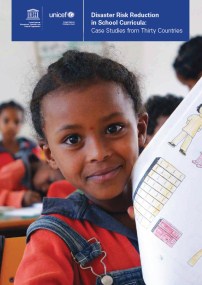
Across thirty case studies, the study examines disciplinary, interdisciplinary and cross-disciplinary manifestations of DRR in the curriculum, strategies for introducing disaster risk reduction into school curricula, pedagogies employed in teaching disaster risk reduction, teacher professional development, DRR learning outcomes and approaches to mainstreaming DRR in the school system. It is argued that DRR tends to appear in a narrow band of school subjects, typically the physical and natural sciences, with little horizontal integration or learning reinforcement across the curriculum. Vertical (through the grade levels) integration of DRR learning is likewise thin. Also, although DRR ambitions are oriented towards competency-building and learner engagement in and with the community, the limited use of participatory pedagogies rather stifles the ambition. Expressed aspirations notwithstanding, forms of learning assessment currently being employed do not lend themselves to measuring whether capacities and dispositions for disaster risk reduction are being cultivated but more or less adhere to traditional testing of knowledge. Systematic professional development directed towards developing the ‘DRR facilitative and reflective practitioner’ is called for. In short, while there are noteworthy examples of curriculum development, use of active pedagogies and successful movement to scale, there is still much to do if the commitment of the ISDR Global Platform for Disaster Risk Reduction to integrating DRR into school curricula worldwide by 2015 is to be realised.
In English
http://unesdoc.unesco.org/images/0021/002170/217036e.pdf
http://www.preventionweb.net/english/professional/trainings-events/edu-materials/v.php?id=26470
http://www.educationandtransition.org/resources/unicefunesco-mapping-of-global-drr-integration-into-education-curricula-sustainability-frontiers/
http://www.ineesite.org/uploads/documents/store/DRR_in_school_curricula_-_mapping_30_countries.pdf
In Nepali
In Portuguese
http://www.unesco.org/ulis/cgi-bin/ulis.pl?catno=220517&set=51EB0F87_2_6&gp=1&lin=1&ll=1
In French
Disaster Risk Reduction Education in Vanuatu: Pilot Curriculum Materials, Teachers’ Guide and Evaluation Instruments
By Fumiyo Kagawa & David Selby, Save the Children Australia. Port Vila, Vanuatu, 2012 (May), 125pp.
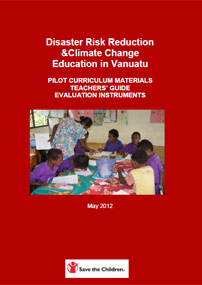
The outcome of a consultancy undertaken by the Sustainability Frontiers team in April and early May 2012, the document was developed in preparation for a Save the Children/Ministry of Education pilot curriculum study involving ten primary schools on Efate Island, Vanuatu, to take place in June and July 2012. It contains some twenty-five learning activities under three headings: Awareness-raising activities; Hazard-specific activities; Resilience-building activities. The activities include: brainstorming sessions; pair, small group and whole class discussion formats; experiential learning units; role play, drama and puppetry; in-the-field community learning; action learning within community partnerships for disaster risk reduction. It also includes evaluation instruments for the pilot as well as instruments for assessing student learning. Advice is given to teachers on classroom management and facilitation of the activities, their roles and responsibilities in data collection and evaluation, and on deploying the DRR student learning assessment instruments.
Disaster Risk Reduction Education in Vanuatu: A Baseline Study for Save the Children Australia
By Fumiyo Kagawa & David Selby, Save the Children Australia, Port Vila, Vanuatu, 2012 (April), 71pp.
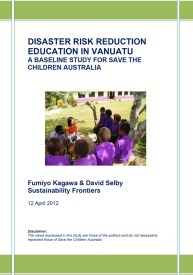
The outcome of a consultancy undertaken by the Sustainability Frontiers team in March and April 2012, the study identifies utilized and unutilized windows of opportunity for disaster risk reduction (DRR) and climate change adaptation (CCA) education within the present Vanuatu primary curriculum and the potential for DRR and CCA learning in the soon-to-be-launched reformed primary curriculum. The present state of the art of disaster-related pedagogy in ten pilot schools is reviewed as are the perspectives of pilot school teachers and students on the quality and relevance of present and potential DRR/CCA curriculum, teachers and students all speaking to the importance of fuller and adequately resourced curriculum. Policy, planning and implementation aspects are also considered, the study ending with a SWOT analysis of disaster risk reduction education in Vanuatu and recommendations for the upcoming Save the Children curriculum development project and for its June/July pilot phase (see above entry).
For the report, go to: http://www.savethechildren.org.au/images/content/where-we-work/vanuatu/Vanuatu_DRR_Curriculum_Baseline_2012.pdf
Building Capacity in Development Education Project: Phase 2 Evaluation.
By David Selby & Fumiyo Kagawa, Centre for Global Education, Belfast, 2010 (November), 87pp.
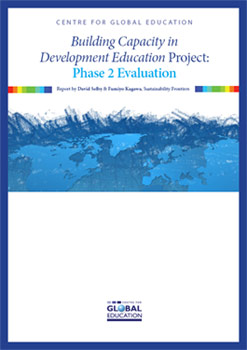 The outcome of an evaluation consultancy undertaken by a Sustainability Frontiers team, this report offers an in-depth evaluation of the second phase (2008-11) of the all-Ireland Building Capacity in Development Education Project of the Centre for Global Education, Belfast. After the Executive Summary, there is an introduction giving the background to the project, a section on evaluation methodology, and then sections on the three project strands: the bi-annual education journal, Policy & Practice: A Development Education Review; the annual conference series; the bi-annual seminar series. The report then stands away from the particular strands and looks at the project as a whole. It ends with recommendations for strengthening each strand and the broader capacity building agenda of the project in the proposed third phase. In the acknowledgements, the Centre for Global Education writes: ‘We wish to extend our thanks to Sustainability Frontiers for the professionalism, courtesy and rigour that they have brought to the evaluation of the project and the presentation of the report’ (p.ii).
The outcome of an evaluation consultancy undertaken by a Sustainability Frontiers team, this report offers an in-depth evaluation of the second phase (2008-11) of the all-Ireland Building Capacity in Development Education Project of the Centre for Global Education, Belfast. After the Executive Summary, there is an introduction giving the background to the project, a section on evaluation methodology, and then sections on the three project strands: the bi-annual education journal, Policy & Practice: A Development Education Review; the annual conference series; the bi-annual seminar series. The report then stands away from the particular strands and looks at the project as a whole. It ends with recommendations for strengthening each strand and the broader capacity building agenda of the project in the proposed third phase. In the acknowledgements, the Centre for Global Education writes: ‘We wish to extend our thanks to Sustainability Frontiers for the professionalism, courtesy and rigour that they have brought to the evaluation of the project and the presentation of the report’ (p.ii).
For the evaluation report, go to: http://www.centreforglobaleducation.com/node/62
